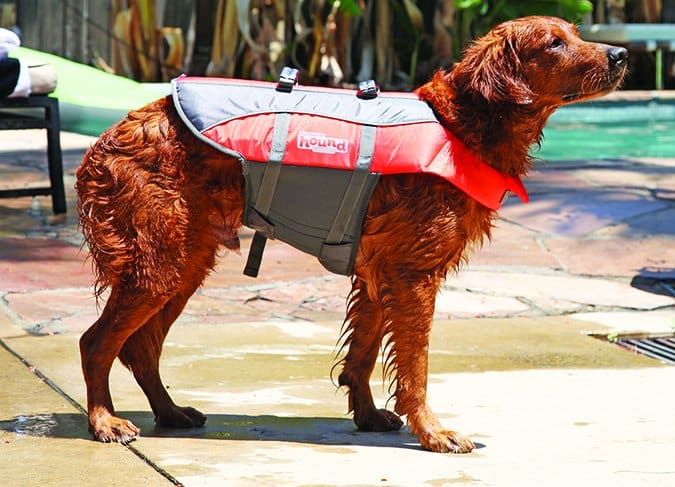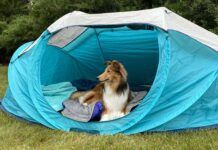With summer well underway, many of us are sharing water-based activities with our dogs, at the shore or in the family pool, or on boats, kayaks, or paddleboards. If you include your dog in water activities, it’s important to take steps to ensure his safety on or near the water. The easiest way to do this is with a well-fitted, good-quality personal flotation device (PFD) for your dog.
Many people think all dogs are natural swimmers; they are not! Even though all dogs instinctively “dog paddle” when they find themselves in water, that alone won’t always keep them safe off-shore. Some dogs dislike the water and are prone to panic when they suddenly find themselves away from dry land. Dogs with significant muscle mass or very little body fat are less buoyant and have a harder time staying afloat – as do older dogs who tire easily, or arthritic dogs. Some are just poor swimmers, bobbing vertically in the water, splashing so much with their front paws that they can’t see where they are going! What about in the case of a watercraft accident, where the dog might be injured? Even athletic, accomplished swimmers can struggle in the water when fatigue unexpectedly sets in after a full day of water play.
In each of these examples, a well-fitting dog life jacket can potentially mean the difference between a day full of happy memories or a tragic ending. Fortunately, there are many dog life jackets to choose from.
A proper life jacket should be bright, making it easy to see, and should have a snug fit. If it’s too loose, it can entangle the dog or come off, or it will float above the dog while the dog bobs along in the water. If it’s too tight, it can chafe and become uncomfortable, making it unlikely the dog will enjoy wearing it. A properly fitting life jacket should not restrict the dog’s movement in or out of the water.
And, of course, a life jacket should be well made, with strong materials and an adequate amount of bouyant material. Some are more buoyant than others – an annoying variable that is not quantified by the pet life jacket makers (see shoulder box at right). But more buoyancy isn’t neccessarily better; one of the most buoyant jackets we tested is also the least stable!
Dog owners also need to consider fit and other functions and features on the vest. Do you need maximum flotation ability for a poor swimmer? A vest that won’t get too hot for a dog who will be onboard a sailboat and needs it for safety, but who won’t actually be swimming much? Are you going to go paddleboarding with your water-loving dog, and need a sturdy handle to help him climb onto the board many times in the course of a boarding/swimming trip? Think about your planned water adventures, and buy accordingly.
We gathered an assortment of canine life jackets, some made by popular manufacturers of dog gear and some made by lesser-known companies with expertise in marine activities, and put them to the test with the help of three “test dogs”: Saber, a 60-pound Golden Retriever; Linus, a 63-pound Labrador Retriever; and Hope, a 28-pound Border Collie.
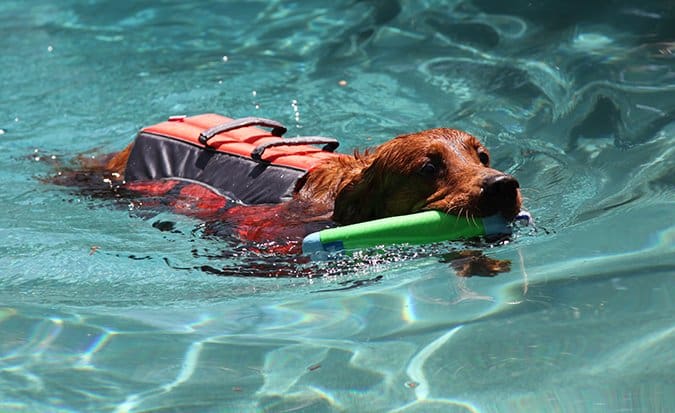
Top Pick Doggy Life Jackets
Two of the canine life jackets we tried on our dogs rose to the top of the test pool, but displayed different strengths. That’s why we are naming two products as our “top picks.” One is best for athletic, accomplished swimmers; the other is best for beginning swimmers and dogs who need more help in the water.
Our top pick for athletic, accomplished swimmers is the West Marine Neoprene Pet Vest. We included this vest in our review due to its sleek design and its maker’s good reputation as a purveyor of boating-related products. A medium vest fit all three of our three athletic models, though it did need to be adjusted to its smallest dimensions to correctly fit the Border Collie.
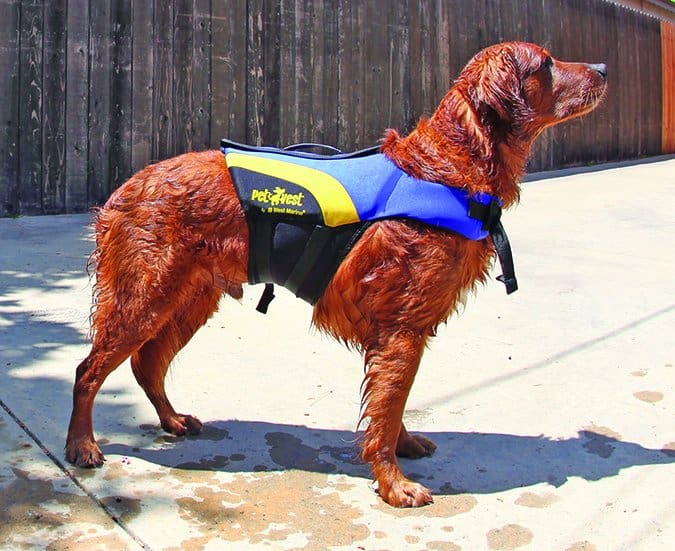
The vest is lightweight, flexible, and very form fitting, more like a wetsuit than a life vest. It features a covered zipper closure along the dog’s back and a quick-release buckle at the chest, with a neoprene band reinforced with nylon straps under the dog’s belly. The wide band successfully kept the life vest in place, even as our dogs ran, swam, and repeatedly leaped into the pool.
On top of the vest is a handle with a reflective stripe and a plastic leash clip. While the handle seems to be well sewn into the jacket, I wouldn’t trust the neoprene material to not tear under the stress of repeatedly using the handle to haul a dog out of the water – especially a larger dog. This would not be our pick for a product that was going to be used repeatedly to lift a dog out of the water.
West Marine’s website doesn’t mention how to properly care for the life vest, but, since it’s made of neoprene, we’d expect care considerations to be similar to that of a wetsuit: to keep the neoprene from fading or drying out, rinse well after use in saltwater or chlorine, and avoid exposing to heat or direct sunlight for extended periods of time. Also, keep in mind that neoprene holds heat, which is great for keeping a dog from getting hypothermic in cold water, but could also help a dog overheat if he were to wear the vest out of the water for too long.
The interior foam layer feels thinner and covers less surface area than the other PFDs we reviewed. This is largely what makes the vest fit so nicely, but also means it doesn’t offer as much buoyancy as some of the other products we tested. West Marine says this vest is designed to “help provide swimming endurance,” meaning that it would not be the best choice for a dog who needs significant support in the water.
That said, we were easily able to observe an increase in our slowest swimmer’s in-water body elevation when she wore this vest, compared to when she swam without a PFD. It was more difficult to observe with the harder-charging Lab and Golden, but we suspect it’s a bit like using counterbalance weights to assist with pull-ups at the gym: you’re doing most of the work, but your effort is boosted just enough to increase your endurance.
For dogs who are novice or weak swimmers, our top pick is Ruffwear’s K9 Float Coat. We tested the medium size, which easily fit Saber and Linus; however, it had to be adjusted to its smallest size to fit Hope snugly; truthfully, a small might have fit her better.
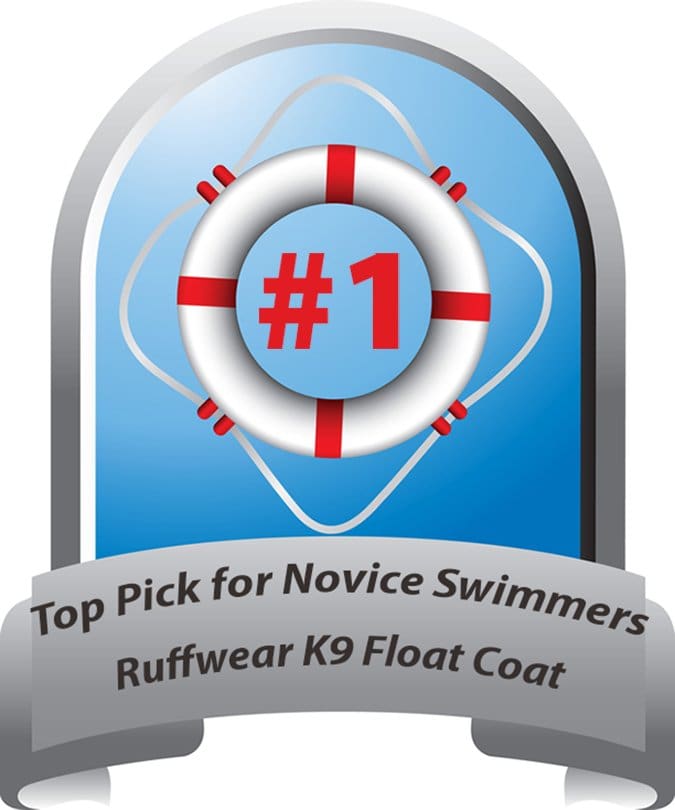
The Float Coat features an adjustable, telescoping chest piece and an overlapping belly panel secured by two quick-release buckles. The excess length on the straps can be folded and held in place with an attached hook-and-loop (Velcro-like) closure, eliminating the need to cut the straps to size to prevent the excess length from dangling and potentially getting caught on something. The telescoping nature of the chest piece makes it less bulky than models where the chest piece overlaps.
The handle on top of the Float Coat feels significantly sturdier than the handles on other vests. There’s also a plastic leash clip (though we’re not sure we’d trust as a sole attachment point for restraining a strong-pulling dog), and an attachment point for The Beacon, Ruffwear’s watertight LED light (sole separately). The jacket is trimmed with reflective piping.
The internal foam feels slightly thicker than the foam in most of the other models we tried. According to Ruffwear, the placement of the inner foam panels is designed to support the dog’s natural swimming position, and all three dogs appeared to maintain a natural swim stroke while wearing the vest. The floatation benefit was most visible when the dogs jumped into the water, as they clearly didn’t submerge as deeply as they did when jumping in the pool with other PFDs.
Ruffwear’s K9 Float Coat looks and feels more durable than the other life vests we tested; it’s a good choice for rugged outdoor adventures.
3-Way Tie for Second Place
We’ll call another tie for the products that we like a bit less than our top picks.
Kurgo’s Surf-n-Turf Coat looks similar to the Ruffwear K9 Float Coat but there are many differences between the two products. The top of the jacket features two sturdy handles, sewn at right angles to each other, so a person who was at any angle to the dog she was trying to fish out of the water is assured to be able to grab at least one of the handles – a thoughtful feature. There is a metal ring for attaching a leash (better than the plastic ring on the Ruffwear vest). There’s also a metal bottle opener – a fun touch that adds a whole new layer to the always enjoyable trick of teaching the dog to fetch a beer!
The Surf-n-Turf Coat is secured by two straps with quick-release buckles under the dog’s belly, and the adjustable chest piece overlaps at the dog’s chest, secured with hook-and-loop and buckled straps. It’s longer than Ruffwear’s Float Coat, so we thought it would be more buoyant. Instead, the added length caused the end of the jacket to float up in the water, away from the swimmer’s body. When the Lab swam with this jacket, his stroke seemed awkward, and he didn’t appear to ride any higher in the water.
Kurgo markets the Surf-n-Turf Coat as a life jacket and three-season shell in one. A zipper along the base of the jacket allows the removal of the inner flotation layer, turning the outer layer into a waterproof coat. Upon closer examination, the flotation layer seemed flimsy, and it suddenly made sense why, even though the Surf-n-Turf Coat is larger, overall, than the K9 Float Coat, it didn’t appear to offer improved buoyancy. The inner layer of the product we tested had several loose threads and a seam that was partially undone.
It was easier than expected to zip the flotation layer back into the jacket, but, overall, we’re not thrilled with the idea of being able to remove the potentially life-saving layer. It feels like this product is trying to be too many things at once.
We tried two different products made by budget-friendly Outward Hound: the H2Go Neoprene Life Vest and the Pupsaver Ripstop Life Jacket. Each product had strengths and weaknesses and features that may be more valuable to some users than others.
The foam in the H2Go Neoprene Life Vest is very thick. There are five foam cells in the vest: two on each side of the dog, and one that sits at the dog’s chest.
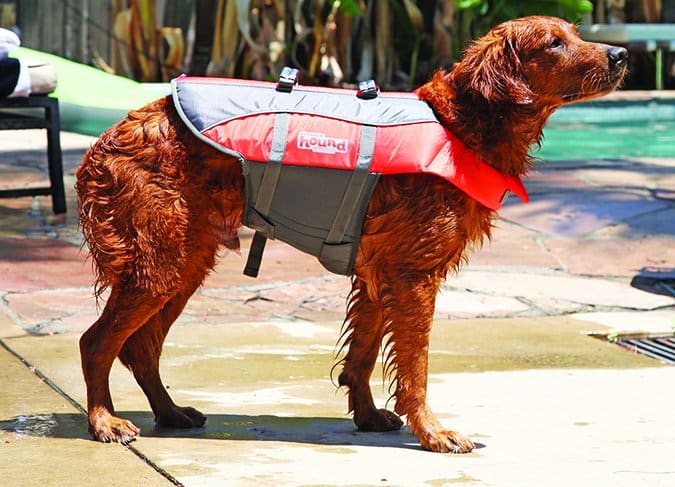
While the Ruffwear and Kurgo vests are designed with flaps that extend down the sides and cover the dog’s belly, the H2Go vest has only a small patch of neoprene attached to the belly straps. This little patch is important because, when properly fit, it helps anchor the vest on the dog to prevent slipping.
To properly fit this vest, one adjusts the belly straps on both sides to make sure the belly patch is centered under the dog – not coming up the side of the dog. We suspect this design element has to do with making sure the dog doesn’t get too hot – a definite consideration with any life vest, but especially one made out of neoprene, which holds heat like a wetsuit. The vest has a similar design at the dog’s chest; rather than extend the vest as a wraparound piece, the H2Go vest has 1-inch nylon straps that connect to an adjustable foam bar that is positioned in the center of the dog’s chest.
Here, again, we have concerns about the durability of a handle sewn into neoprene, when it must have the potential to hoist 85-plus pounds of wet dog out of the water. Pulling the handle on dry land just once or twice exposed stitching between the handle and the jacket. We’d like to think it would hold up in an emergency, but we suspect it would likely be a “one and done” situation. Not the end of the world, so long as the handle holds up when you really need it, but we wouldn’t select this jacket for applications where we’d need the handle to repeatedly lift a dog, as one might do when paddleboarding with a dog who likes to swim.
Buoyancy-wise, the H2Go offered a lot of visible “lift” in the water. It was almost too much for my strong-swimming dog, Saber, who naturally swims very high and horizontal in the water. At times, it almost looked like the excess lift along his body was tipping his head and chest toward the water line. This might not have been the case if the vest had more flotation material at the chest, rather than just the single bar. Dogs who tend to use their front legs more than their back legs when swimming, with their back ends more under water, might benefit from this vest the most. Seeing how well this vest lifted the bulk of my dog’s body, I can imagine it working well to help level dogs who haven’t yet developed a more efficient swim stroke.
Outward Hound’s Pupsaver Ripstop Life Jacket is similar in design to the Kurgo and Ruffwear vests, but offers a less-contoured fit, especially along the dog’s back. The Pupsaver has neoprene flaps that fully wrap around the underside of the dog, secured by both hook-and-loop fasteners and quick-release buckles. The vest’s interior foam continues in the overlapping chest piece, which is also secured with a hook-and-loop fastener and a buckle. Unique to the Pupsaver is an additional “flap” of foam that lies over the chest closure. The website describes this as a “front float,” which is designed to “keep your pup’s head above water.” This “front float,” plus the foam inserts in the chest piece, definitely gives this vest a lot of flotation material at the front end of the dog.
This vest also has two handles, a thoughtful detail to help better distribute the dog’s weight while being lifted, and to make it possible for two people to work together to lift a heavy dog, if needed. While I would question the long-term durability of the handles if used often, the ripstop nylon seemed stronger than the neoprene handles on other products.
Even when properly sized, this vest looks boxy compared to the higher-end models. It reminded us of the PFDs that are given to a person when renting a boat for a day as opposed to the type you might buy for yourself if you were a regular participant in water sports. Appearances aside, it offers nice buoyancy without appearing to over-lift the dog’s back as compared to the chest/head and seems like a fair choice if your dog needs a life jacket for occasional use.
| RANK | PRODUCT/PRICE/CONTACT | SIZES; MEASUREMENTS |
| 1 (tie): Ranked first for dogs with strong swimming skills. | West Marine Neoprene Pet Vest $40-43; (800) 262-8464 |
Available in S-XL. Size using combination of chest, length and body weight measurements. |
| 1 (tie): Ranked first for novice or poor swimmers. | Ruffwear K-9 Float Coat $79; (888) 783-3932 |
Available in XXS-XL. Size using chest measurement. |
| 2 (tie) | Kurgo Surf-n-Turf Coat $35-$60; (877) 847-3868 |
Available in XS-XL. Size using combination of chest, length and neck measurements. |
| Outward Hound H2Go Neoprene Life Vest $21-$30; (800) 477-5735 | Available in XS-XL. Size using combination chest, length, and neck measurements and body weight. | |
| Outward Hound PupSaver Ripstop Life Jacket $17-$26; (800) 477-5735 |
Available in XS-XL. Size based on body weight. | |
| Not recommended | Kong Sport Aqua Float Dog Flotation Vest $29-$50; (818) 717-1116 |
Available in XXS-XL. Size based on chest measurement. |
| MTI UnderDog Pet Life Jacket $42-$60; (800) 783-4684 |
Available in XS-XL. Size based on body weight. |
Not Recommended
We wouldn’t recommend buying either of the final two products we tested.

0)]
The overall design of the Kong Sport Aqua Float Dog Flotation Vest is almost identical to the Outward Hound Pupsaver Ripstop vest. However, on closer examination, its features appear to be of lesser quality. For example, the quick-release buckles that secure the belly flap are unnecessarily large in size, yet feel somewhat flimsy when in use. The buckle securing the chest piece was smaller, but the nylon strap kept slipping (negating the correct fit) when very little pressure was applied.
The Kong Sport Aqua Float vest covered the most surface area on the dog of any of the vests, and it has the widest belly flap. The extra width of the belly flap meant we really had to cinch it in on the narrow waist of our athletic Lab. Our model, Linus, was at the bottom of size range for the large vest; it’s possible a medium vest might have fit better. Still, it seems like the design of this vest would better accommodate an overall wider dog with a less-defined waist.
The bigger issue is this vest’s lack of flotation support. Even though the product itself is bigger and covers more surface area on the dog, the interior foam feels thinner, and we didn’t notice any obvious support from the jacket as our dog moved through the water.
But the performance of the last vest we tested was potentially far worse. We were actually really excited about trying the MTI UnderDog Pet Life Jacket, because, unlike just about every other pet life jacket, with flotation support located on the top of the jacket, the UnderDog is designed with the flotation material underneath the dog. According to the company’s website, “by moving 90 percent of the effective buoyancy under the chest and neck, the vest is designed to allow a more natural swim angle with the hind legs lower than the front.”
While this might be a common swim angle among dogs who aren’t as comfortable in the water, or who aren’t as skilled in their natural swim technique, I disagree that it’s more “natural” for dogs to swim with their hind legs lower than the front. In my experience, the ideal, efficient swim technique is one that keeps the dog’s body fairly horizontal in the water. Still, a jacket designed to focus on lifting the dog’s front end seems to make sense from a safety perspective.
And so, the design of this vest is opposite that of the other products we’ve described. A mesh panel stretches across the dog’s back, securing the flotation cells underneath the dog, and is secured with hook-and-loop fasteners and plastic quick-release buckles. Another mesh piece extends from under the dog toward his neck, where a thick foam-filled “collar” snaps into place. This vest has, by far, the thickest foam of any of the vest we tried. The foam on the body portion of the vest is 1½”, and the foam in the neck piece is ¾”. With this much sturdy foam, we expected our experienced swimmers to practically walk on water!
Unfortunately, that amount of flotation material makes the vest extremely boxy, and challenging to achieve and maintain a snug fit. We were surprised by how tight we had to adjust the vest to keep it in place underneath the dog’s chest. It’s hard to imagine such a fit being comfortable, even though the under-body flotation did cause Saber to swim noticeably higher in the water.
The real problems started after a short amount of calm swim time. Despite the tight fit at the start, the vest still managed to slide toward Saber’s waist. A difference of only a couple of inches appeared to cause Saber to float almost uncontrollably! In that position, the body of the vest seemed to dramatically counteract his natural movements. If his weight shifted to the left (for example, when turning to go after a toy), the buoyancy threw him to the right; he’d try to counter the shift, which instantly left him fish-tailing like a big rig truck about to jackknife on the highway!
We’re perfectly willing to accept that we might not have achieved the perfect fit with this jacket. It felt snug and looked correct on dry land, but maybe the fit was still off? Also, we wonder if this jacket would do better to support a wider dog? Our test dog is lean and narrow, which meant the vest fit underneath him at a more pronounced angle. On a heavier, more log-shaped dog, the angle would open up, potentially creating greater stability/less overall shift in the water. We’re still intrigued by the design, but, having seen better results with other products, we would not recommend the UnderDog at this time.
Stephanie Colman is a writer and dog trainer in Los Angeles.


